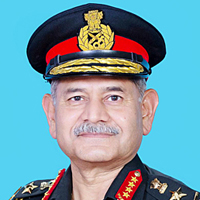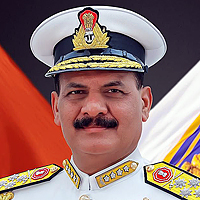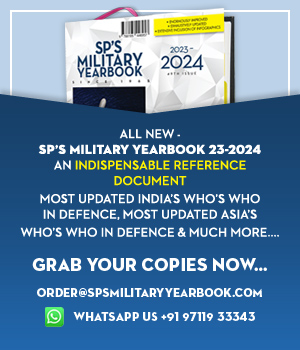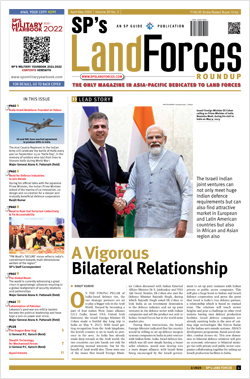INDIAN ARMED FORCES CHIEFS ON OUR RELENTLESS AND FOCUSED PUBLISHING EFFORTS

The insightful articles, inspiring narrations and analytical perspectives presented by the Editorial Team, establish an alluring connect with the reader. My compliments and best wishes to SP Guide Publications.

"Over the past 60 years, the growth of SP Guide Publications has mirrored the rising stature of Indian Navy. Its well-researched and informative magazines on Defence and Aerospace sector have served to shape an educated opinion of our military personnel, policy makers and the public alike. I wish SP's Publication team continued success, fair winds and following seas in all future endeavour!"

Since, its inception in 1964, SP Guide Publications has consistently demonstrated commitment to high-quality journalism in the aerospace and defence sectors, earning a well-deserved reputation as Asia's largest media house in this domain. I wish SP Guide Publications continued success in its pursuit of excellence.
- All about HAMMER Smart Precision Guided Weapon in India — “BEL-Safran Collaboration”
- US to sell $93 million precision artillery, Javelin and Excalibur projectiles to India
- US to sell $93 million precision artillery, Javelin and Excalibur projectiles to India
- India, Germany deepen defence ties as High Defence Committee charts ambitious plan
- True strategic autonomy will come only when our code is as indigenous as our hardware: Rajnath Singh
- India-Israel Joint Working Group Meeting on defence cooperation to boost technology sharing and co-development
- G20 Summit: A Sign of Global Fracture
Protecting the Nation with a Cohesive BMS

General Dynamics UK experience of C4I programmes, and delivering interoperability and integration, is key to the success of India’s Battlefield Management System
India, as we know, is planning to modernise the communications systems used by its armed forces in order to give it a military advantage. Adding command and control capability through a cohesive Battlefield Management System (BMS) will without doubt deliver this decisive edge. But a debate about BMS is currently growing in India, and it is a debate that I have seen in other parts of the world. These debates centre around two key words—interoperability and integration.
As the tempo of operations increases on a daily basis, soldiers, their commanders and their supporting forces on the ground, in the air or at sea need to be joined up so that all components of the fighting force are aware of, and can respond to any given situation. Every soldier needs to know where their allies are and what they are thinking, as well as where the enemy is and how to anticipate its next move. They also need to be able to react to the decisions of their commanders at a moment’s notice.
Speed and clarity of communication are key to out-manoeuvring the enemy and protecting one’s own forces and people.
Put in the context of a country such as India, where internal threats are as much of a concern as external threats, this capability would be of benefit not only to the Indian Army but to paramilitary, police and emergency forces around the country. Greater cooperation between such forces would contribute to greater stability and security. For such cooperation to be possible interoperability becomes essential.
But interoperability is not simply about ensuring that friendly military and security forces can communicate effectively with each other to support a defensive action or posture. Interoperability is actually the next major step forward for command and control capability.
Delivering such capability is not as simple as it might sound. Each customer will have their own requirements, standards and doctrine which will have an effect on the ‘shape’ of their command and control system. Yet cooperating forces will also want to be able to share information using their respective systems.
For example, the British Army’s ‘Bowman’ programme differs from the Royal Netherlands Marine Corps NIMCIS programme because of slightly differing requirements and equipment, yet the two systems can talk to each other easily, underpinning the close cooperation and operational interoperability of the UK/Netherlands Landing Force.
But successful interoperability does not simply result from providing a BMS-type system to every unit one wishes to include in a command, control and communications framework. It also results from understanding and successfully integrating that system with already existing legacy systems, vehicles and infrastructure. As General Dynamics UK has learnt from its experience in working with its customers, good integration is a key component of good interoperability
It is also because of the complexity of getting such capabilities right that many armed and security forces who wish to benefit from command and control capability look to General Dynamics UK Limited, the company recognised as the leading prime systems integrator with the greatest experience of delivering cutting edge command and control solutions around the world.
General Dynamics UK designs, from scratch, the system that works for the customer. It can do this because it is product independent. The majority of other defence contractors do not understand this factor and attempt to impose their own solutions on the customer by offering a vertically integrated system and equipment package that does not necessarily fit the customer’s needs.
By taking the product independent approach General Dynamics UK can more effectively deliver capabilities such as an integrated mobile tactical Internet offering secure-voice, secure-data, situational awareness and video capabilities throughout the battlespace, to a large user population both dismounted and in vehicles, in units, headquarters and command posts.





